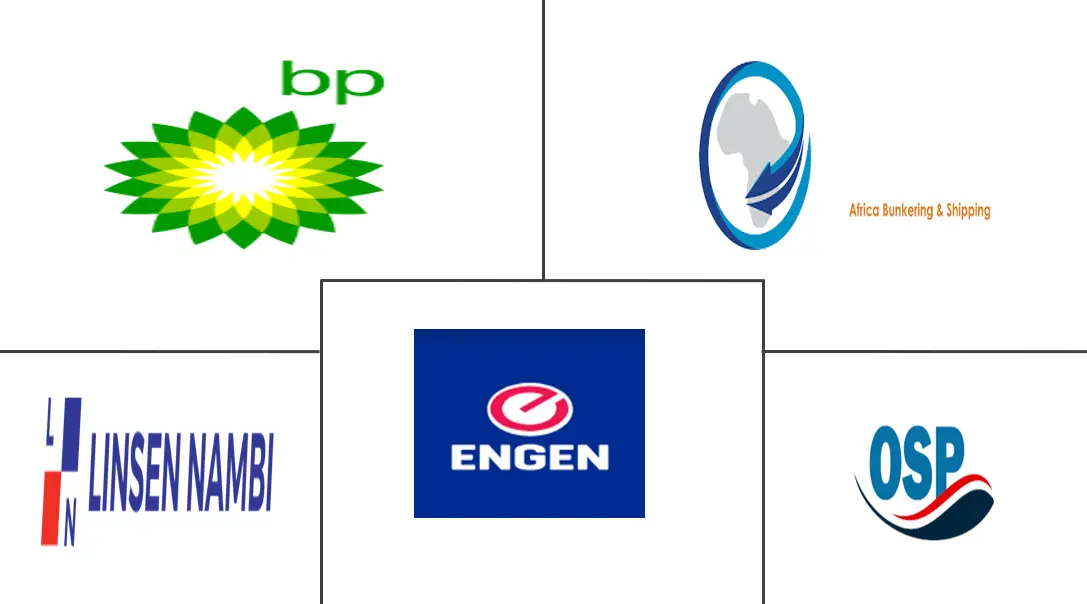South Africa Bunker Fuel Market Size and Share
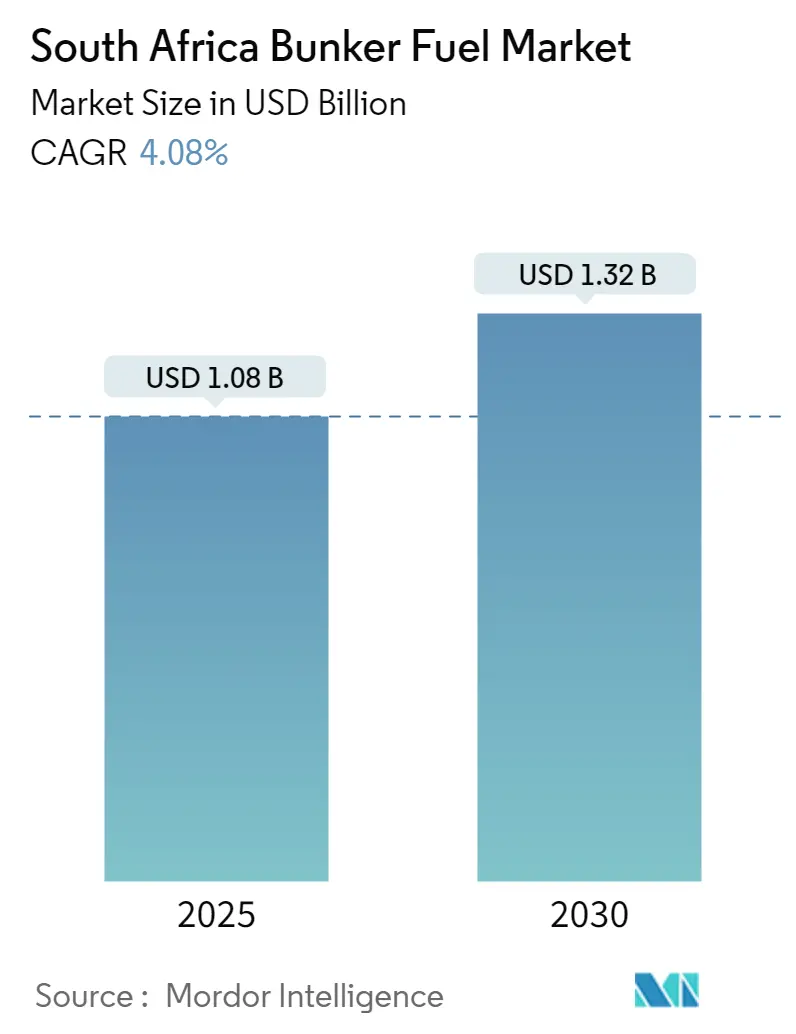
South Africa Bunker Fuel Market Analysis by Mordor Intelligence
The South Africa Bunker Fuel Market size is estimated at USD 1.08 billion in 2025, and is expected to reach USD 1.32 billion by 2030, at a CAGR of 4.08% during the forecast period (2025-2030).
- Over the medium period, factors such as increasing maritime trade and supportive government policies toward low-emission bunker fuel in the country are expected to drive the market during the forecast period.
- On the other hand, changes in the cost of bunker fuel and crude oil are expected to hinder the market's growth.
- Nevertheless, the adoption of bunker fuel with low greenhouse gas emissions is needed to reduce the environmental impact of shipping on the planet, which is expected to create several future market opportunities during the forecast period.
South Africa Bunker Fuel Market Trends and Insights
Increasing Maritime Trade Driving the Market
- South Africa is a major player in the global shipping industry, with several major ports along its coastline. South Africa has diversified its economy beyond traditional industries like mining and agriculture, expanding into manufacturing and services. This led to increased imports and exports as the country needed to import raw materials and intermediate goods to support its manufacturing and service industries while also exporting finished goods.
- South Africa is on a key international sea route vital for global maritime transport. Growth in maritime trade is expected to drive the country’s demand for bunker fuel. The United Nations Conference on Trade and Development (UNCTD) reported a significant increase in the import of goods from the country in recent years. According to UNCTD’s data, the value of imported goods reached USD 130.7 billion in 2023, which was slightly lower than in 2022 but represented an almost 55.5% increase compared to 2020. This import trade growth indicates rising maritime activities in South African ports and, consequently, the country's higher consumption of bunker fuels.
- Furthermore, as the country aims to expand trade and investments with neighboring nations, increasing trade agreements are expected to boost future demand for the bunker fuels market. This growth is driven by a strategic focus on enhancing economic ties and facilitating smoother trade operations.
- For instance, in January 2024, South Africa exported its first shipment to Ghana and other countries under the African Continental Free Trade Area (AfCFTA) agreement. With this development and being a coastal country, the country targets grabbing trade opportunities through marine shipping, thereby driving demand for bunker fuel usage.
- South Africa is one of the world's leading mining and mineral processing countries and is home to some of the world's largest and most profitable mining companies. South Africa is rich in mineral resources, including gold, diamonds, platinum, coal, and iron ore. These resources have attracted significant investments in mining and exploration and have helped support the export activities of the country’s minerals industry.
- In addition, the South African government implemented policies and initiatives aimed at promoting export trade, such as the Export Marketing and Investment Assistance Scheme (EMIA), Tariff Restructuring Program, Sector Assistance Scheme (SSAS), Rebate Provisions, Export Credit and Foreign Investment Reinsurance Scheme (ECRS), and Duty Credit Certificate Scheme (DCCS). Such initiatives are expected to increase maritime trade and demand for bunker fuel during the forecast period.
- Such projects and initiatives are likely to increase maritime trade across the country as well as boost demand for bunker fuel during the forecast period.
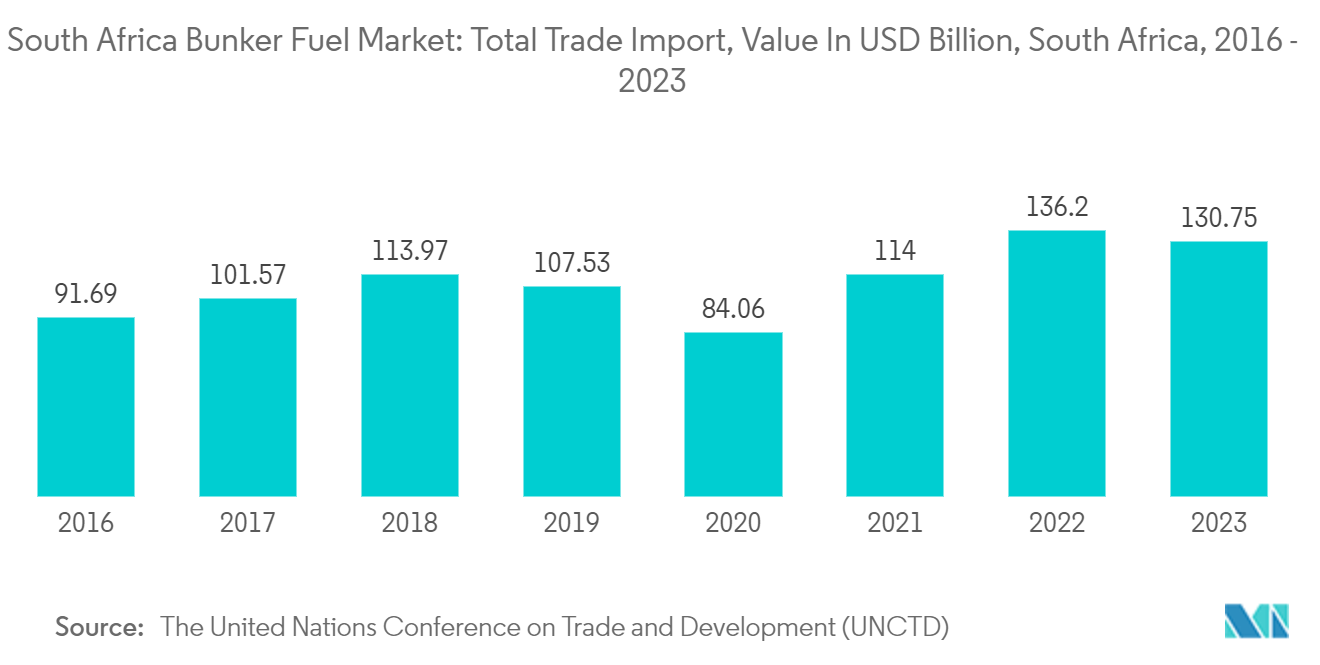
LNG to Witness Significant Growth as a Bunker Fuel Segment
- The South African LNG bunkering industry has developed over the last decade, driven by increased global LNG usage, clean energy demand, and the opportunity to minimize greenhouse gas emissions. LNG-powered vessels are registering progressively higher demand, and lower natural gas prices have signaled the start of an expansion in the market for these kinds of vessels.
- LNG bunkering can take place at a terminal or a dedicated LNG bunkering station, or it can be carried out through truck-to-ship or ship-to-ship transfers. The process involves specialized equipment and procedures to ensure LNG’s safe and efficient transfer and compliance with international regulations and standards.
- The demand for LNG as a bunker fuel has been rising significantly in recent years due to rising environmental concerns and increased use of cleaner fuel across the country. Natural gas consumption, including LNG, has grown rapidly in the last few years. According to the Statistical Review of World Energy Data, in 2023, the country's natural gas consumption was 4.7 billion cubic meters, 9.3% higher than in 2022. The consumption is expected to increase in the coming years as the government recently issued several LNG bunkering licenses to start LNG bunkering operations across the country.
- In addition, the upcoming advancements in LNG regasification and storage capacity at the Richard Bay terminal of South Africa are expected to boost LNG as a bunker fuel in the South African market during the forecast period. For instance, in January 2024, South Africa's Transnet National Ports Authority appointed Vopak and Transnet Pipelines to construct and manage the Port of Richards Bay import facility. Vopak Terminal Durban and Transnet Pipelines are meanwhile seeking parties interested in securing capacity at their upcoming LNG import terminal, the Zululand Energy Terminal.
- Further, South Africa is also geographically close to several countries with large natural gas reserves, where field development has been accelerated due to rising global LNG demand. South Africa has explored the possibility of importing LNG through two separate ports, Richards Bay and Coega.
- Additionally, South Africa’s economy is based on resource extraction. It is a major producer of iron ore, coal, and other bulk resources that must be transported via large marine vessels. Most producers and shipping companies focus on reducing emissions according to Industry 4.0 standards and net-zero targets.
- For instance, in January 2023, Anglo American announced that the Ubuntu Harmony, a newly launched liquefied natural gas (LNG) dual-fueled Capesize+ vessel, had loaded its first cargo of iron ore from its Kumba operations in South Africa. The growing adoption of LNG in powering field operations and marine vessels to reduce industrial emissions is expected to positively impact the demand for LNG bunkering services for large marine vessels over the coming years.
- Hence, driven by high domestic demand, recent developments, and upcoming projects, the market is likely to register increased demand for LNG as a bunker fuel during the forecast period.
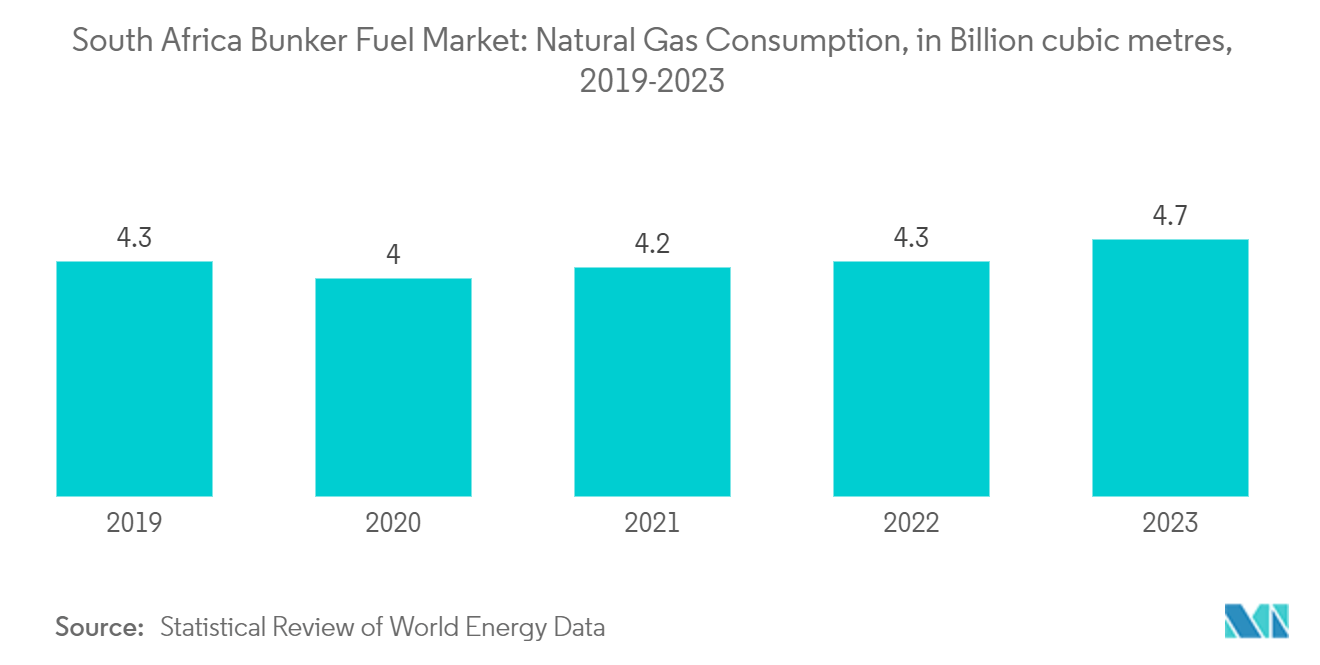
Competitive Landscape
The South African bunker fuel market is semi-consolidated. Some of the major players in this market (in no particular order) include Linsen Nambi Bunker Services (Pty) Ltd, BP PLC (BP Southern Africa Pty Ltd), Ocean South Petroleum RSA (Pty) Ltd, Engen Petroleum Ltd, and Africa Bunkering and Shipping (Pty) Ltd, among others.
South Africa Bunker Fuel Industry Leaders
-
Linsen Nambi Bunker Services (Pty) Ltd
-
BP Plc (BP Southern Africa Pty Ltd)
-
Ocean South Petroleum RSA (Pty) Ltd
-
Engen Petroleum Ltd
-
Africa Bunkering and Shipping (Pty) Ltd
- *Disclaimer: Major Players sorted in no particular order
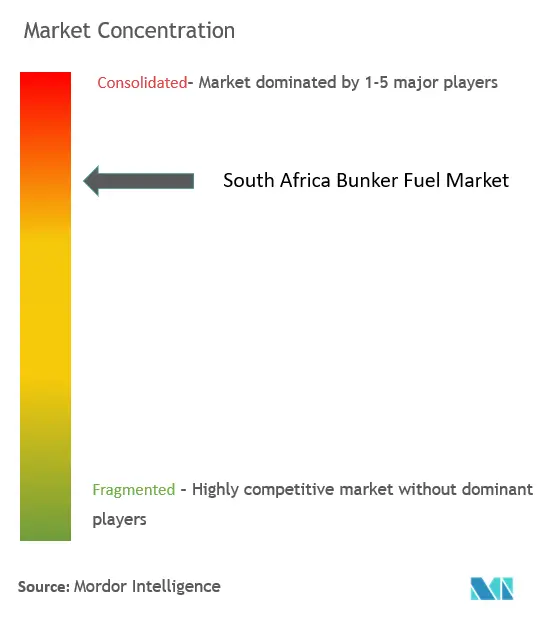
Recent Industry Developments
- April 2024: Navigator Holdings (Navigator Gas), based in the United Kingdom and operating a fleet of handy-size liquefied gas carriers, successfully conducted its inaugural ship-to-ship ammonia transfer. At the Port of Ngqura in South Africa, Navigator Gas' 38,000 cbm liquefied petroleum gas (LPG) carrier, NAVIGATOR JORF, took on 25,300 metric tons of anhydrous ammonia (NH3) from the LPG tanker ECO ORACLE, while both vessels were moored side by side.
- March 2023: South Africa and Europe launched a new maritime green corridor project to transport iron ore between the two regions. The project includes forming a consortium to find ways to achieve zero-emission shipping. Companies like Anglo American, Tata Steel, CMB, VUKA Marine, Freeport Saldanha, and ENGIE are expected to collaborate to develop the green corridor through bunkering and offtake arrangements, green bunker fuel supplies, and financial and business model alternatives.
South Africa Bunker Fuel Market Report Scope
Bunker fuel refers to any fuel pumped into a ship's bunkers to power its combustion engines. Deep-sea cargo ships often burn the heavy, residual oil that remains after gasoline, diesel, and other light hydrocarbons are removed from crude oil during the refining process.
The South African bunker fuels market is segmented by fuel type and vessel type. By fuel type, the market is segmented into high sulfur fuel oil (HSFO), very low sulfur fuel oil (VLSFO), marine gas oil (MGO), liquefied natural gas (LNG), and other fuel types. By vessel type, the market is segmented into containers, tankers, general cargo, bulk carriers, and other vessel types. For each segment, the market sizing and forecasts have been done based on value (USD).
| High Sulfur Fuel Oil (HSFO) |
| Very Low Sulfur Fuel Oil (VLSFO) |
| Marine Gas Oil (MGO) |
| Liquefied Natural Gas (LNG) |
| Other Fuel Types |
| Containers |
| Tankers |
| General Cargo |
| Bulk Carriers |
| Other Vessel Types |
| Fuel Type | High Sulfur Fuel Oil (HSFO) |
| Very Low Sulfur Fuel Oil (VLSFO) | |
| Marine Gas Oil (MGO) | |
| Liquefied Natural Gas (LNG) | |
| Other Fuel Types | |
| Vessel Type | Containers |
| Tankers | |
| General Cargo | |
| Bulk Carriers | |
| Other Vessel Types |
Key Questions Answered in the Report
How big is the South Africa Bunker Fuel Market?
The South Africa Bunker Fuel Market size is expected to reach USD 1.08 billion in 2025 and grow at a CAGR of 4.08% to reach USD 1.32 billion by 2030.
What is the current South Africa Bunker Fuel Market size?
In 2025, the South Africa Bunker Fuel Market size is expected to reach USD 1.08 billion.
Who are the key players in South Africa Bunker Fuel Market?
Linsen Nambi Bunker Services (Pty) Ltd, BP Plc (BP Southern Africa Pty Ltd), Ocean South Petroleum RSA (Pty) Ltd, Engen Petroleum Ltd and Africa Bunkering and Shipping (Pty) Ltd are the major companies operating in the South Africa Bunker Fuel Market.
What years does this South Africa Bunker Fuel Market cover, and what was the market size in 2024?
In 2024, the South Africa Bunker Fuel Market size was estimated at USD 1.04 billion. The report covers the South Africa Bunker Fuel Market historical market size for years: 2019, 2020, 2021, 2022, 2023 and 2024. The report also forecasts the South Africa Bunker Fuel Market size for years: 2025, 2026, 2027, 2028, 2029 and 2030.
Page last updated on:
South Africa Bunker Fuel Market Report
Statistics for the 2025 South Africa Bunker Fuel market share, size and revenue growth rate, created by Mordor Intelligence™ Industry Reports. South Africa Bunker Fuel analysis includes a market forecast outlook for 2025 to 2030 and historical overview. Get a sample of this industry analysis as a free report PDF download.
